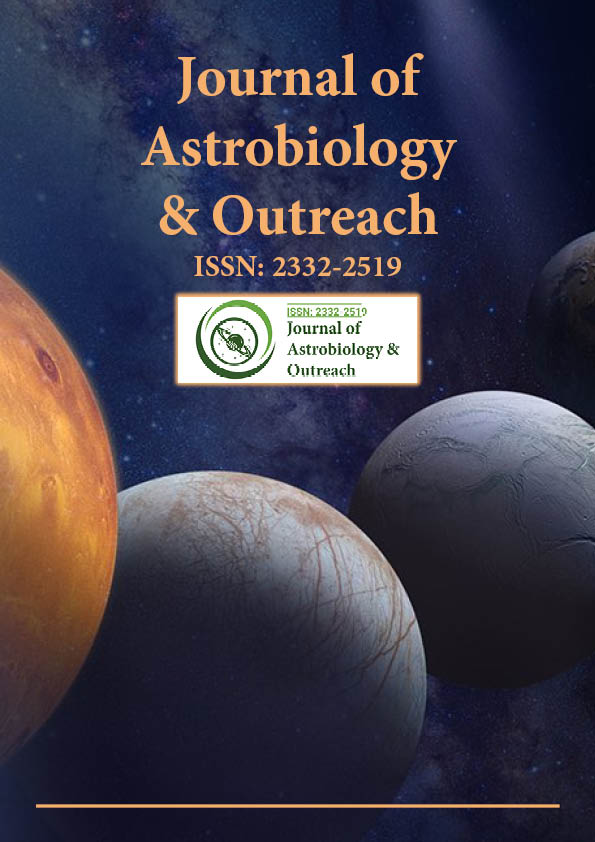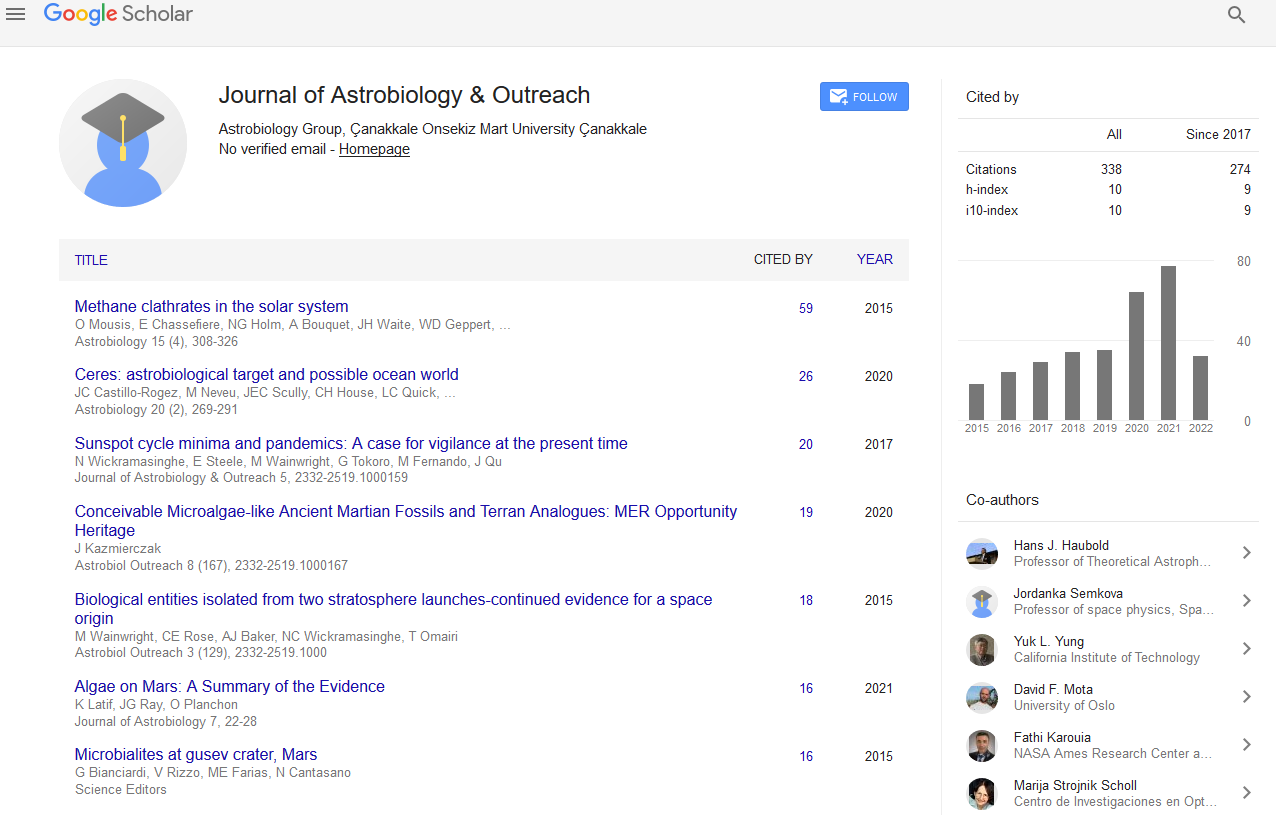Indexed In
- Open J Gate
- Academic Keys
- JournalTOCs
- RefSeek
- Hamdard University
- EBSCO A-Z
- OCLC- WorldCat
- Google Scholar
Useful Links
Share This Page
Journal Flyer

Open Access Journals
- Agri and Aquaculture
- Biochemistry
- Bioinformatics & Systems Biology
- Business & Management
- Chemistry
- Clinical Sciences
- Engineering
- Food & Nutrition
- General Science
- Genetics & Molecular Biology
- Immunology & Microbiology
- Medical Sciences
- Neuroscience & Psychology
- Nursing & Health Care
- Pharmaceutical Sciences
Opinion Article - (2024) Volume 12, Issue 2
Isotopic Insights into Earthâs Structure and Solar System Origins
Taehoon Kang*Received: 28-May-2024, Manuscript No. JAO-24-27368; Editor assigned: 31-May-2024, Pre QC No. JAO-24-27368 (PQ); Reviewed: 14-Jun-2024, QC No. JAO-24-27368; Revised: 21-Jun-2024, Manuscript No. JAO-24-27368 (R); Published: 28-Jun-2024, DOI: 10.35248/2332-2519.24.12.347
Description
Geochemistry and cosmochemistry are essential fields in understanding both Earth’s processes and the formation of celestial bodies. Applications in these disciplines extend across a wide range of research areas, from studying Earth’s structure and the evolution of life to analyzing meteorites for insights into solar system origins. As we continue to expand the tools and techniques available, the implications of discoveries in geochemistry and cosmochemistry reach into both academic and applied sciences, providing essential insights into environmental sustainability, resource management and planetary exploration. In geochemistry the chemical composition and processes occurring within Earth’s layers. This includes studying elements and isotopes in rocks, minerals and soils, as well as understanding their transformations over time. Such analysis allows scientists to trace processes that shape the planet’s crust, mantle and core, such as tectonic movement, volcanic activity and mineral deposition. Geochemists also focus on interactions between Earth's atmosphere, hydrosphere and lithosphere, including how chemical elements cycle through these systems. By identifying and analyzing these cycles, researchers can understand the balance of critical elements like carbon, nitrogen and oxygen, which are essential to life on Earth. In cosmochemistry, the focus shifts to the chemical analysis of extraterrestrial materials such as meteorites, cosmic dust and samples from lunar and planetary missions. This helps to address fundamental demands about the solar system's formation, the origins of planets and the conditions that could allow life to develop elsewhere. Cosmochemists study isotopic compositions, trace elements and minerals in these samples, examining the clues they hold about the processes that occurred during the early solar system. Through isotope geochemistry, for instance, scientists can identify the distinct “fingerprints” of chemical processes that were active during the formation of the planets and other celestial bodies.
One practical application in geochemistry lies in environmental monitoring. Geochemists study pollution sources, track the movement of contaminants in groundwater and soil and assess the environmental impact of industrial activities. For example, by measuring isotopic ratios of specific pollutants, it is possible to trace sources of contamination, understand how pollutants travel through different ecosystems and identify the degradation rate of hazardous materials. This analysis is essential for developing remediation strategies and assessing risks to human health and the environment. It also provides governments and regulatory agencies with the scientific data necessary to make informed decisions regarding environmental policies and resource management. Geochemistry also intersects with economic geology in applications such as mineral exploration. By analyzing geochemical signatures in specific regions, scientists can predict the presence of valuable minerals, metals, or oil deposits. This work involves detailed mapping and sampling, sometimes involving thousands of samples over vast areas. The information derived from these studies informs the mining industry about where to extract resources efficiently and sustainably. This approach minimizes environmental impacts by ensuring extraction efforts are focused only on the richest, most accessible deposits.
In cosmochemistry, isotopic analysis plays a essential role in determining the age of celestial materials. This dating technique is applied to meteorites, moon rocks and Martian soil samples, providing insight into the chronology of events in the solar system. By understanding the age of these materials, scientists can reconstruct the timeline of solar system formation, including the periods during which planets developed and potential conditions for life may have arisen. This field has far-reaching implications for the study of exoplanets as well, where the lessons learned about our solar system can be applied to other planetary systems beyond it.
The fields of geochemistry and cosmochemistry also converge in the study of isotopic anomalies, which provide insight into processes that predate the solar system. Some meteorites contain isotopic signatures that are thought to be remnants from ancient stars, preceding the formation of the Sun. Analyzing these isotopic signatures allows scientists to hypothesize about the types of stellar environments that contributed to the material that eventually formed our solar system. These findings offer a connection between planetary science and astrophysics, as they reveal information about the origins and lifecycles of stars and planetary systems. Furthermore, computational models have become a significant tool in these fields, enabling scientists to simulate geochemical processes under different conditions. These models help to predict how elements behave under specific pressures and temperatures, such as those within Earth’s mantle or in the atmospheres of distant planets. By combining laboratory data with simulations, researchers can extrapolate findings to broader contexts, making it easier to interpret data from places that are challenging or impossible to sample directly.
Both geochemistry and cosmochemistry continue to expand our understanding of Earth, our solar system and the universe. They provide insights into the distribution of elements, the behavior of chemical compounds and the processes that transform them. From practical applications in environmental management and resource extraction to theoretical research on solar system formation, these disciplines have a significant impact on science and society. As new technologies and methodologies continue to evolve, the potential for discovery within geochemistry and cosmochemistry grows, deepening our understanding of the world we live in and the universe beyond.
Citation: Kang T (2024). Isotopic Insights into Earth’s Structure and Solar System Origins. J Astrobiol Outreach. 12:347.
Copyright: © 2024 Kang T. This is an open-access article distributed under the terms of the Creative Commons Attribution License, which permits unrestricted use, distribution, and reproduction in any medium, provided the original author and source are credited.

